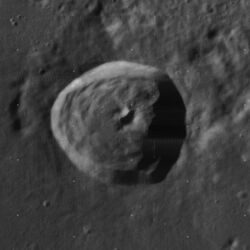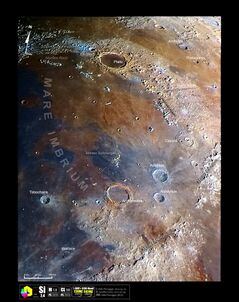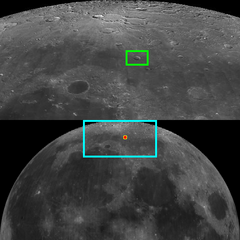Astronomy:Archytas (crater)
 Lunar Orbiter 4 image | |
| Diameter | 32 km |
|---|---|
| Depth | 2.4 km |
| Colongitude | 355° at sunrise |
Archytas is a lunar impact crater that protrudes into the northern edge of Mare Frigoris. To the northwest is the comparably sized crater Timaeus, and the smaller Protagoras lies in the opposite direction to the southeast. Further to the southwest, beyond the opposite edge of the mare, is the dark-floored crater Plato.
The rim of Archytas is sharp-edged and shows little appearance of erosion due to subsequent impacts. The outer wall is nearly circular, with a slight outward bulge in the southeast. The interior is rough, with a ring of material deposited at the base of the inner wall. Just to the east of the crater midpoint is a pair of central peaks.
The surface surrounding the crater is relatively smooth to the south due to the lava flows that formed the mare. The surface is more rugged to the north and northeast. The satellite crater Archytas B, located to the northwest of Archytas, forms a lava-flooded bay along the edge of the Mare Frigoris.
Archytas is a crater of Eratosthenian age.[1]
Satellite craters
By convention these features are identified on lunar maps by placing the letter on the side of the crater midpoint that is closest to Archytas.
| Archytas | Latitude | Longitude | Diameter |
|---|---|---|---|
| B | 61.3° N | 3.2° E | 36 km |
| D | 63.5° N | 11.8° E | 43 km |
| G | 55.6° N | 0.5° E | 7 km |
| K | 62.6° N | 7.7° E | 15 km |
| L | 56.2° N | 0.9° E | 5 km |
| U | 62.8° N | 9.2° E | 8 km |
| W | 61.2° N | 5.2° E | 6 km |
References
- ↑ The geologic history of the Moon. USGS Professional Paper 1348. By Don E. Wilhelms, John F. McCauley, and Newell J. Trask. U.S. Government Printing Office, Washington: 1987. Table 12.2.
- Andersson, L. E.; Whitaker, E. A. (1982). NASA Catalogue of Lunar Nomenclature. NASA RP-1097.
- Blue, Jennifer (July 25, 2007). "Gazetteer of Planetary Nomenclature". USGS. http://planetarynames.wr.usgs.gov/.
- Bussey, B.; Spudis, P. (2004). The Clementine Atlas of the Moon. New York: Cambridge University Press. ISBN 978-0-521-81528-4.
- Cocks, Elijah E.; Cocks, Josiah C. (1995). Who's Who on the Moon: A Biographical Dictionary of Lunar Nomenclature. Tudor Publishers. ISBN 978-0-936389-27-1. https://archive.org/details/isbn_9780936389271.
- McDowell, Jonathan (July 15, 2007). "Lunar Nomenclature". Jonathan's Space Report. http://host.planet4589.org/astro/lunar/.
- Menzel, D. H.; Minnaert, M.; Levin, B.; Dollfus, A.; Bell, B. (1971). "Report on Lunar Nomenclature by the Working Group of Commission 17 of the IAU". Space Science Reviews 12 (2): 136–186. doi:10.1007/BF00171763. Bibcode: 1971SSRv...12..136M.
- Moore, Patrick (2001). On the Moon. Sterling Publishing Co.. ISBN 978-0-304-35469-6. https://archive.org/details/patrickmooreonmo00patr.
- Price, Fred W. (1988). The Moon Observer's Handbook. Cambridge University Press. ISBN 978-0-521-33500-3.
- Rükl, Antonín (1990). Atlas of the Moon. Kalmbach Books. ISBN 978-0-913135-17-4.
- Webb, Rev. T. W. (1962). Celestial Objects for Common Telescopes (6th revised ed.). Dover. ISBN 978-0-486-20917-3. https://archive.org/details/celestialobjects00webb.
- Whitaker, Ewen A. (1999). Mapping and Naming the Moon. Cambridge University Press. ISBN 978-0-521-62248-6.
- Wlasuk, Peter T. (2000). Observing the Moon. Springer. ISBN 978-1-85233-193-1.
External links
 |





